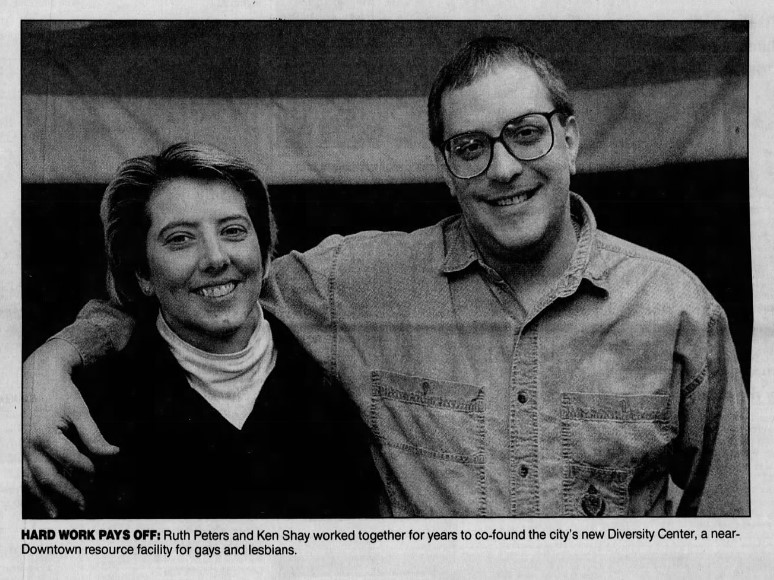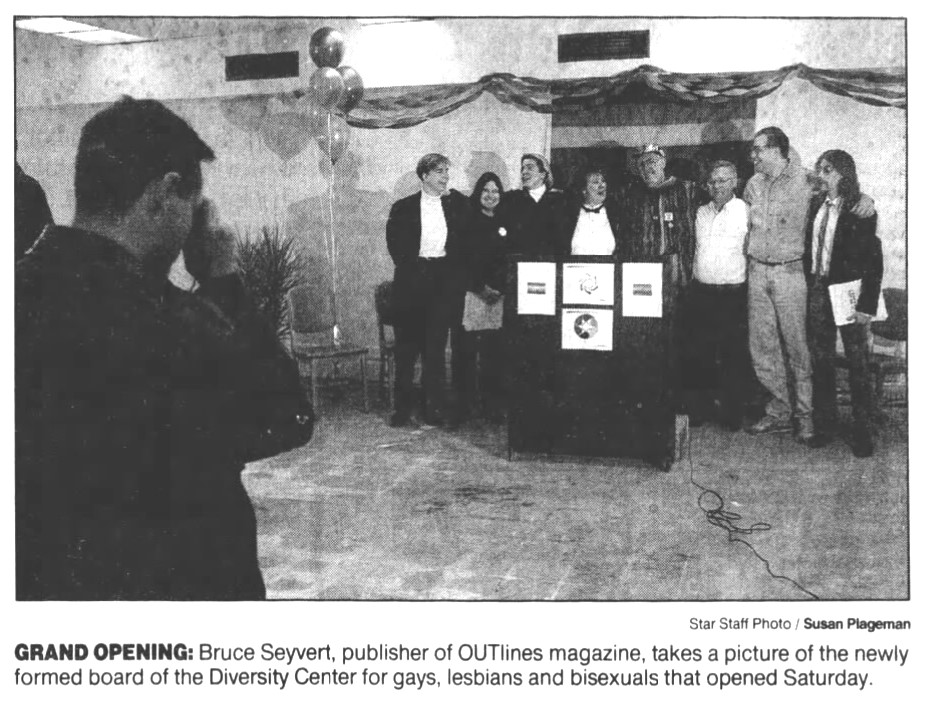Ruth Peters and Ken Shay conceived of the idea for the Diversity Center in 1993, a time when there were few, if any, public spaces friendly to the gay and lesbian community. Lack of funding delayed the center’s anticipated opening from June 1994 to March 4, 1995, when it finally opened as a community center for “gays, lesbians, and bisexuals” of Indianapolis and the surrounding area.

Fundraising efforts generated roughly $15,000. The money allowed for a 2-year lease of basement space in the (ICLU) 4,000 square foot building at 1211 E. Shadeland Avenue. This included a large meeting room and library that functioned as both a meeting space and a physical safe space for Indianapolis’ gay and lesbian organizations and activities.
Funding to run the Diversity Center came almost exclusively through donations, fundraising events, and individual memberships. Membership to the center cost $25 a year, with lifetime memberships running $500. Membership privileges included reduced rates on center services and activities and discounts at participating businesses. By the time the facility opened, there were 225 members and 25 lifetime members.
The ultimate goal of the Diversity Center was to move to a larger permanent building with enough room to accommodate the estimated 40 to 50 gay and lesbian organizations in Indianapolis. This, however, required increased membership. Peters and Shay estimated that at least 1,000 members would be required to generate the funds needed as a down payment toward purchasing a building for the Diversity Center.
In the meantime, the Diversity Center worked out of its rented space. In addition to holding programs geared towards the LGBTQ+ population, the center offered meeting spaces and a kitchen facility for community organizations. The center also published a community newsletter, “Diversifications,” which began in 1994 before the center’s official opening.

The board of directors of the Diversity Center outlined two goals: the center should shape the future of the LGBTQ+ community and preserve the community’s past. By providing a safe space for the LGBTQ+ community the Diversity Center fulfilled its first goal. To accomplish its second goal, the Diversity Center celebrated its past by collecting books and other material about gays and lesbians. These items found a home in a library and archive that was open to the public. Named after who founded the , the opened at the Diversity Center on June 11, 1995.
Michael Bohr (1948-2023), a gay activist who understood the importance of preserving the history of the LGBTQ+ community, spearheaded the effort to establish the library and archives in honor of Gonzalez. Bohr already had a collection of 1,600 materials documenting gay life in Indiana, but he solicited donations of books, money, and physical materials such as bookshelves to expand the collection. By the time the library and archive opened, Bohr had amassed a collection of 2,000 items.
Six months after its opening, the Diversity Center faced its first brush with controversy. It opened under the premise of being fully operational; however, the board members failed to reveal the additional work needed to make the building handicap accessible at its grand opening festivities. As a result, some groups, including the Lesbian, Gay, Bisexual, Transgender Fairness group, refused to meet at the Diversity Center. With no elevator, the basement location of the Diversity Center was inaccessible to people with disabilities. The group stated the Diversity Center failed to recognize transgender individuals in its mission statement, an omission that was corrected in 1996. Furthermore, the board of directors failed to acknowledge non-receipt of an anonymous donor’s $50,000 pledge. This meant the Diversity Center started with funds closer to $12,000, a fourth of which the Diversity Center used in materials to upgrade the building. Lastly, the center struggled to find volunteers to keep the center open more than a few hours two days a week.
Two years later the Diversity Center faced additional public criticism for an incident surrounding PrideFest in 1997. As a frequent supporter of events in Indianapolis’ LGBTQ+ scene, including PrideFest activities, the center faced controversy after withdrawing its support from the 1997 PrideFest events. That year, PrideFest organizers used a derogatory slur in part of its slogan to capitalize on PrideFest coinciding with Flag Day. The slogan, “Fag Day on Flag Day,” garnered criticism from the Diversity Center and two LGBTQ+ choruses for being “exclusionary to lesbian women, derogatory to gay men and disrespectful to our countries’ veterans and patriots.” The and the pulled out of the event. Event sponsor Ted Fleischaker, publisher and owner of The Indiana Word, a statewide gay and lesbian newspaper, immediately apologized and withdrew the offending slogan. Still, the Diversity Center received public backlash for withdrawing its support of a hallmark event in the history of the gay rights movement.
As the years passed, the Diversity Center continued to face financial hardship. Operating costs at the center became insurmountable which led to the closure of Indianapolis’ first LGBTQ+ specific community center in the mid-2000s. Though the center closed, the Chris Gonzalez Library and Archives found a home at the , Central branch.

Help improve this entry
Contribute information, offer corrections, suggest images.
You can also recommend new entries related to this topic.